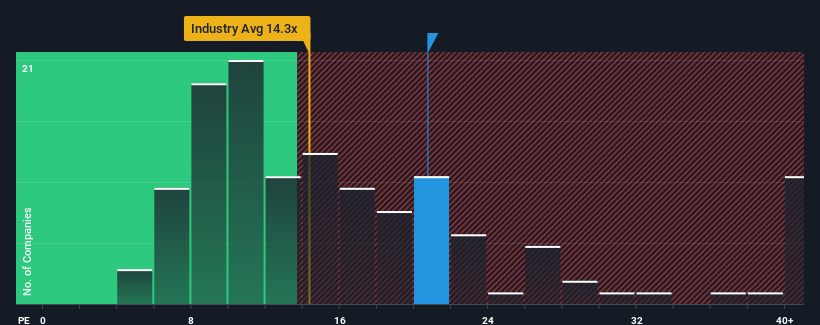Earnings Not Telling The Story For Nippon Sanso Holdings Corporation (TSE:4091)

With a price-to-earnings (or "P/E") ratio of 20.7x Nippon Sanso Holdings Corporation (TSE:4091) may be sending bearish signals at the moment, given that almost half of all companies in Japan have P/E ratios under 14x and even P/E's lower than 9x are not unusual. Although, it's not wise to just take the P/E at face value as there may be an explanation why it's as high as it is.
With earnings growth that's superior to most other companies of late, Nippon Sanso Holdings has been doing relatively well. The P/E is probably high because investors think this strong earnings performance will continue. If not, then existing shareholders might be a little nervous about the viability of the share price.
View our latest analysis for Nippon Sanso Holdings

How Is Nippon Sanso Holdings' Growth Trending?
In order to justify its P/E ratio, Nippon Sanso Holdings would need to produce impressive growth in excess of the market.
Retrospectively, the last year delivered an exceptional 42% gain to the company's bottom line. The strong recent performance means it was also able to grow EPS by 91% in total over the last three years. So we can start by confirming that the company has done a great job of growing earnings over that time.
Turning to the outlook, the next three years should generate growth of 9.4% each year as estimated by the eight analysts watching the company. Meanwhile, the rest of the market is forecast to expand by 11% each year, which is not materially different.
With this information, we find it interesting that Nippon Sanso Holdings is trading at a high P/E compared to the market. It seems most investors are ignoring the fairly average growth expectations and are willing to pay up for exposure to the stock. These shareholders may be setting themselves up for disappointment if the P/E falls to levels more in line with the growth outlook.
The Bottom Line On Nippon Sanso Holdings' P/E
Generally, our preference is to limit the use of the price-to-earnings ratio to establishing what the market thinks about the overall health of a company.
We've established that Nippon Sanso Holdings currently trades on a higher than expected P/E since its forecast growth is only in line with the wider market. When we see an average earnings outlook with market-like growth, we suspect the share price is at risk of declining, sending the high P/E lower. This places shareholders' investments at risk and potential investors in danger of paying an unnecessary premium.
Before you settle on your opinion, we've discovered 1 warning sign for Nippon Sanso Holdings that you should be aware of.
Of course, you might also be able to find a better stock than Nippon Sanso Holdings. So you may wish to see this free collection of other companies that have reasonable P/E ratios and have grown earnings strongly.
Valuation is complex, but we're here to simplify it.
Discover if Nippon Sanso Holdings might be undervalued or overvalued with our detailed analysis, featuring fair value estimates, potential risks, dividends, insider trades, and its financial condition.
Access Free AnalysisHave feedback on this article? Concerned about the content? Get in touch with us directly. Alternatively, email editorial-team (at) simplywallst.com.
This article by Simply Wall St is general in nature. We provide commentary based on historical data and analyst forecasts only using an unbiased methodology and our articles are not intended to be financial advice. It does not constitute a recommendation to buy or sell any stock, and does not take account of your objectives, or your financial situation. We aim to bring you long-term focused analysis driven by fundamental data. Note that our analysis may not factor in the latest price-sensitive company announcements or qualitative material. Simply Wall St has no position in any stocks mentioned.
About TSE:4091
Nippon Sanso Holdings
Engages in the gas business in Japan, the United States, Europe, Asia, and Oceania.
Adequate balance sheet with moderate growth potential.


